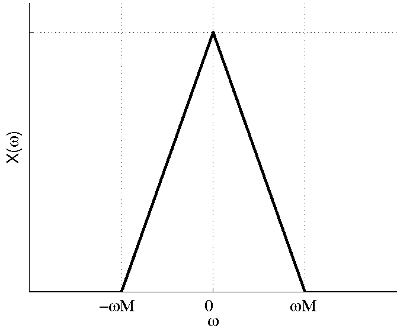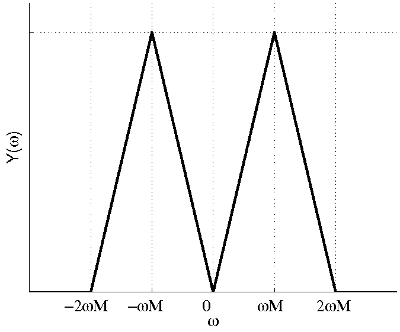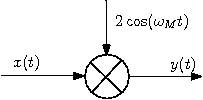Homework 10 Solutions, ECE301 Spring 2011 Prof. Boutin
Students should feel free to make comments/corrections or ask questions directly on this page.
Question 1
a) We can write
- $ y_1(t)=e^{j \theta_c}x(t)e^{j\omega_c t} $
Notice that this is exactly as modulating by $ e^{j\omega_c t} $ but now we are multiplying with a complex exponential independent of t (phase shift). We can recover the signal x(t) for any ωc, and hence there are no conditions put on ωc.
b) In order to recover signal x(t), we multiply y1(t) by $ e^{-j(\omega_c t+\theta_c)} $.
c) We can write
- $ y_2(t)=x(t)\left(\frac{e^{j\omega_c t}-e^{-j\omega_c t}}{2j}\right) $
Taking the FT of y2(t), we get:
- $ \begin{align} \mathcal{Y}_2(\omega)&=\frac{1}{2\pi(2j)}\mathcal{X}(\omega)*[2\pi\delta(\omega-\omega_c)-2\pi\delta(\omega+\omega_c)] \\ &=\frac{1}{2j}\mathcal{X}(\omega-\omega_c)-\frac{1}{2j}\mathcal{X}(\omega+\omega_c) \end{align} $
Now, to insure that we can recover signal x(t) we need to avoid having the two images of X(ω) overlap. Hence we need ωc > ωM. But ωM = 2000π / 2 = 1000π. Hence in order for x(t) to be recoverable we need:
- ωc > 1000π
d) In order to recover signal x(t) we multiply y2(t) by sin(ωct) first. The signal after multiplying with sin(ωct) is:
- $ \begin{align} r(t)&=y_2(t)\sin(\omega_c t) \\ &=\sin^2(\omega_c t)x(t) \\ &=\frac{1}{2}x(t)-\frac{1}{2}\cos(2\omega_c t)x(t) \end{align} $
Thus in order to recover x(t) we need to filter out the second term of r(t) and amplify the remainder by a factor of 2 (you may want to draw the FT of r(t) to verify this in the frequency domain). To achieve that, we pass r(t) through a low pass filter with a cut-off frequency ωc'u't = ωM = 1000π and gain 2. The frequency response of this low pass filter is:
- $ \mathcal{H}(\omega)=\left\{\begin{array}{ll} 2, & \mbox{ for } |\omega|<1000\pi\\ 0, & \mbox{ elsewhere} \end{array}\right. $
Note that the cut-off frequency of the low pass filter can actually be anywhere between ωM and 2ωc − ωM.
Question 2
a) The Fourier series coefficients of c(t) are:
- $ \begin{align} a_k&=\frac{\sin(\frac{2\pi k 10^{-3}}{4\times 10^{-3}})}{\pi k} \\ &=\frac{\sin{\frac{\pi k}{2}}}{\pi k} \end{align} $
and using the synthesis equation of the Fourier series we get:
- $ c(t)=\sum_{k=-\infty}^{\infty} a_k e^{j\frac{2\pi k}{T}t}=\sum_{k=-\infty}^{\infty} a_k e^{j2000\pi kt} $
Taking the FT of the latter sum, we get:
- $ \mathcal{C}(\omega)=2\pi\sum_{k=-\infty}^{\infty}a_k \delta(\omega-2000\pi k) $
Now, let y(t) = x(t)c(t), then:
$ \begin{align} \mathcal{Y}(\omega)&=\frac{1}{2\pi}\mathcal{X}(\omega)*\mathcal{C}(\omega) \\ &=\frac{1}{2\pi}\mathcal{X}(\omega)*2\pi\sum_{k=-\infty}^{\infty}a_k \delta(\omega-2000\pi k) \\ &=\sum_{k=-\infty}^{\infty}a_k \mathcal{X}(\omega-2000\pi k) \end{align} $
In order to recover x(t) we need to avoid aliasing and hence 2000π > 2ωM. Then ωM < 1000π.
b) We need to find a0 since the image at DC is multiplied by it:
- $ a_0=\lim_{k\to 0}\frac{\sin{\frac{\pi k}{2}}}{\pi k}=\frac{\frac{\pi k}{2}}{\pi k}=\frac{1}{2} $
Now, to recover x(t) we need to filter out the images other than the image at DC and and multiply it by $ \frac{1}{a_0}=2 $. Hence we use a low pass filter with the following frequency response:
- $ \mathcal{H}(\omega)=\left\{\begin{array}{ll} 2, & \mbox{ for } |\omega|<\omega_{M}\\ 0, & \mbox{ elsewhere} \end{array}\right. $
Note that the cut-off frequency of the low pass filter can actually be anywhere between ωM and 2000π − ωM.
Question 3
a) We can assume any illustrative shape for the spectrum of signal x(t) as long as it is band-limited between − ωM and ωM.
Thus the spectrum of y(t) is:
b) A block diagram of the scrambler that can generate the signal y(t) can be:
You can verify that by taking the FT of 2x(t)cos(ωMt).
c) The following block diagram describes a descrambler which can recover signal x(t) from y(t).
where $ \mathcal{H}(\omega)=\left\{\begin{array}{ll} 1, & \mbox{ for } |\omega|<\omega_M\\ 0, & \mbox{ elsewhere} \end{array}\right. $.
Note that $ \mathcal{H}(\omega) $ is the frequency response of a low pass filter with cut-off frequency equals to ωM.
You can verify that the system in the above block diagram can recover signal x(t) by following the same reasoning of part d) in Question 1.
Question 4
a)
$ \begin{align} X(s)&=\int_{-\infty}^{\infty}e^{-5t}u(t+3)e^{-st} dt \\ &=\int_{-3}^{\infty}e^{-(5+s)t} dt \\ &=-\frac{1}{s+5}e^{-(5+s)t}\Bigg|^{\infty}_{-3} \\ &=\frac{e^{3(5+s)}}{s+5} \end{align} $
where the ROC is:
- $ \mathcal{R}e\{5+s\}>0 $
- $ 5+\mathcal{R}e\{s\}>0 $
- $ \mathcal{R}e\{s\}>-5 $
This is an example where the ROC appears "like magic" at the end. Four points should be taken off for this. In order to get full credit, you must specify at which point the equality fails to hold in your computation of the Fourier transform. For example, like this:
$ \begin{align} X(s)&=\int_{-\infty}^{\infty}e^{-5t}u(t+3)e^{-st} dt \\ &=\int_{-3}^{\infty}e^{-(5+s)t} dt \\ &=-\frac{1}{s+5}e^{-(5+s)t}\Bigg|^{\infty}_{-3} \\ &=\left\{ \begin{array}{ll} \frac{e^{3(5+s)}}{s+5},& \text{ if } \mathcal{R}e\{s\}>-5\\ diverges, & \text{ else.} \end{array} \right. \end{align} $
b)
$ \begin{align} X(s)&=\int_{-\infty}^{\infty}e^{-5t}u(-t+5)e^{-st} dt \\ &=\int_{-\infty}^{5}e^{-(5+s)t} dt \\ &=-\frac{1}{s+5}e^{-(5+s)t}\Bigg|_{-\infty}^{5} \\ &=\left\{ \begin{array}{ll} -\frac{e^{-5(5+s)}}{s+5}& \text{ if } \mathcal{R}e\{s\}<-5\\ diverges, & \text{ else.} \end{array} \right. \end{align} $
c)
$ \begin{align} X(s)&=\int_{-\infty}^{\infty}e^{-5t}[u(t)-u(t-3)]e^{-st} dt \\ &=\int_{0}^{3}e^{-(5+s)t} dt \\ &=-\frac{1}{s+5}[e^{-3(5+s)}-1]\\ &=\frac{1}{s+5}-\frac{e^{-3(5+s)}}{s+5} \end{align} $
where we did not need to constraint our result to a ROC (which is expected since the signal has finite duration).
d)
$ \begin{align} X(s)&=\int_{-\infty}^{\infty}e^{-2|t|}e^{-st}dt \\ &=\int_{-\infty}^{0}e^{2t}e^{-st}dt + \int_{0}^{\infty}e^{-2t}e^{-st}dt \\ &=\int_{-\infty}^{0}e^{(2-s)t}dt + \int_{0}^{\infty}e^{-(2+s)t}dt \\ &=\frac{1}{2-s}e^{(2-s)t}\Bigg|^{0}_{-\infty}-\frac{1}{2+s}e^{-(2+s)t}\Bigg|_{0}^{\infty} \end{align} $
Now consider the first term:
$ \begin{align} \frac{1}{2-s}e^{(2-s)t}\Bigg|^{0}_{-\infty} &= \left\{ \begin{array}{ll} \frac{1}{2-s} & \text{ if } \mathcal{R}e\{s\}<2\\ diverges, & \text{ else.} \end{array} \right. \end{align} $
So the ROC for this first term is $ \mathcal{R}e\{s\}<2 $.
QUESTION: I understand that there is a pole at 2, but how do you know which direction the ROC goes (> or <)?
Now consider the second term:
$ \begin{align} -\frac{1}{2+s}e^{-(2+s)t}\Bigg|_{0}^{\infty}&= \left\{ \begin{array}{ll} \frac{1}{2+s} & \text{ if } \mathcal{R}e\{s\}>-2\\ diverges, & \text{ else.} \end{array} \right. \end{align} $
So the ROC for this second term is $ \mathcal{R}e\{s\}>-2 $.
Thus the ROC for the sum of both terms is the intersection of those two constraints, and hence the ROC is $ -2<\mathcal{R}e\{s\}<2 $.
Question 5
Since the Laplace transform of x(t) has exactly two poles at s = − 1 and s = − 3, then the ROC could be any of the following three:
- $ \mathcal{R}e\{s\}<-1 $
- $ \mathcal{R}e\{s\}<-3 $
- $ -3<\mathcal{R}e\{s\}<-1 $
But it is given that the FT of e2tx(t) converges and hence s = − 2 belongs to the ROC of the Laplace transform of x(t).
Hence the ROC is $ -3<\mathcal{R}e\{s\}<-1 $.
Since the ROC is $ -3<\mathcal{R}e\{s\}<-1 $, we deduce that the given signal is a sum of a right-sided signal and a left-sided signal. Thus, x(t) should be a two-sided signal.
Hence:
a) No
b) No
c) Yes
Can you explain how you got s = -2 in more detail? I keep getting that the FT of exp(2t)x(t) = X(jw-2), which makes me think, for s = jw, X(s-2) --> s = 2.
- TA's comment: Since the FT of $ e^{2t}x(t) $ converges then the following integral converges:
- $ \color{blue}\int_{-\infty}^{\infty}e^{2t}x(t)e^{-j\omega t}dt=\int_{-\infty}^{\infty}x(t)e^{-(-2+j\omega)t}dt $
- Comparing the above integral with the definition of the Laplace transform we notice that it is $ X(s) $ but with $ \color{blue}\mathcal{R}e\{s\}=-2 $ and hence the Laplace transform of $ x(t) $ converges for all s with $ \color{blue}\mathcal{R}e\{s\}=-2 $.
Question 6
In order to find the inverse Laplace transform of X(s), we need to find its partial fraction expansion.
First we compute the roots of the denominator, and then we get:
- $ X(s)=\frac{2(s+2)}{s^2+7s+12}=\frac{2(s+2)}{(s+3)(s+4)} $
Now we write:
- $ X(s)=\frac{A}{s+3}+\frac{B}{s+4} $
Multiplying both sides by (s + 3)(s + 4) and simplifying, we get:
- 2s + 4 = (A + B)s + 4A + 3B
Comparing and solving, we have that: A = − 2 and B = 4.
Thus,
- $ X(s)=-\frac{2}{s+3}+\frac{4}{s+4} $
Now since the ROC is $ \mathcal{R}e\{s\}>-3 $, then x(t) should be a right sided signal or equivalently the sum of right sided signals. Hence,
- x(t) = [ − 2e − 3t + 4e − 4t]u(t)





